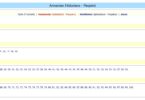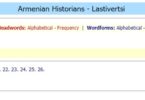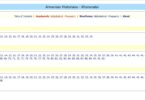Opening Remarks by Tom Samuelian Dean,
College of Humanities & Social Sciences
American University of Armenia
April 13, 2016
Colloquium on Genocide & Literature:
Israeli and Armenian Comparative Perspectives
AUA is celebrating its 25th anniversary this year. During this quarter century there have been many firsts. Today is another first for AUA. We welcome a group of distinguished guests from Israel, writers, scholars, journalists, to join a group of distinguished Armenian writers, scholars and researchers, to explore the topic of Genocide and Literature from Israeli and Armenian Comparative Perspectives.
This, however, is not new ground in Armenian studies or for Armenian Genocide scholars. Nearly a quarter century ago, Prof. Rubina Peroomian published her seminal work on this topic, Literary Responses to Catastrophe: A comparison of the Armenian and the Jewish Experience, followed by a series of insightful studies, including The Armenian Genocide in Literature: Perceptions of Those who Live through the Years of Calamity, And those who continued living in Turkey after 1915 : metamorphosis of the post-genocide Armenian identity as reflected in artistic literature, and Armenian Genocide in Literature: Second Generation Responses. Similarly, this topic has been explored by historians, sociologists and ethnographers, including our guest this evening, Dr. Harutyun Marutyan of the Armenian National Academy of Sciences, and UCLA Prof. and Armenian Academy of Sciences Academician Richard Hovannissian. Among Prof. Hovannissian’s many works dedicated to various aspects of the Armenian Genocide, there are several specifically addressing the topic of our colloquium, including The Armenian Genocide: Cultural and Ethical Legacies (edited by Richard Hovannisian, ed.), and Enlightenment and Diaspora: the Armenian and Jewish Cases (edited by Richard G. Hovannisian and David N. Myers, ed.), as well as earlier works, such as a volume edited by Prof. Hovannisian, The Armenian Image in Literature and History, and Leo Hamalian’s As Others See Us. And there is a significant body of work on Franz Werfel’s 40 Days of Musa Dagh and its message for European Jews and the world, including the work of our own visiting Prof. Yair Auron, who was instrumental in organizing this colloquium.
So we find ourselves in territory explored by great minds and scholars. It is a broad and complex field of comparative research and with much yet to be discovered and explored. Next week, AUA’s Digital Library will launch a new collection comprising the works of Authors who Perished in the Genocide making this extensive body of literature available for the first time in a single and searchable format, opening new horizons for readers and researchers in this field. As for this colloquium, perhaps its distinctive feature is the focus on the literature of the two homelands restored to independence in the 20th century.
There is no doubt much in common and much that distinguishes the experiences and the landscapes of the literary imagination of these two countries and peoples. Both have modern literary traditions that emerged in the 19th century, building on centuries of ancient, medieval, classical, religious and secular literary work, and both share literary roots in the Bible. Both modern states were born in the wake of genocide, the haven of orphaned and traumatized masses, formed in the crucible of life-or-death battles. Both continue to struggle for peace and security. Yet there are important differences as well.
Unlike Israel, Armenia is surrounded by the unrepentant perpetrators of the Armenian Genocide, who have not atoned for their barbarity. It is recent as yesterday’s news. The immediacy of Artsakh puts genocide in a different light and puts Armenian writers and readers in a different frame of mind.
Unlike Israel, Armenia recognizes the Jewish Holocaust along with other genocides and deems it its duty to bear witness and condemn all crimes against humanity in order to uphold the norms of civilization and the community of nations. This asymmetry too has its reflection in literary works.
Like Israel, Armenia regained independence after surviving Genocide, but unlike Israelis who regained a homeland, Armenians lost a large part of their indigenous homeland. The loss of Western Armenia deprived Armenians of the habitat in which they had created their lives, language and culture since time immemorial. This loss is another asymmetry that has its reflection in literary works. This loss also makes the liberation of Artsakh yet more poignant and central to Armenian sensibilities.
As Pope Francis said a year ago, the Armenian Genocide is an “open wound,” not just for Armenians but for humanity. If genocide can be perpetrated with impunity, denied, and benefited from by the perpetrators and others who self-interestedly delay recognition and remedy, then the real norm is that “genocide pays and can be perpetrated with impunity.” Harsh though it may sound, this is, to use Justice Holmes’s formulation, the “bad man” theory of the law. If an act has no consequences, then it is permissible. Sadly, this is the current international norm and no doubt this bad precedent has not been lost on ISIS and others in the region. Now, once again, innocents are paying the price, by the thousands, in random, unprovoked, barbaric destruction, not just in the Middle East, Syria and Turkey, but in Europe, the United States, and other parts of the world as well. They, like the Armenians and Jews, are the collateral damage of a man-made catastrophe formulated in the corridors of power by myopic greed, fear, and disregard for the welfare of others. These realities inescapably inform our analysis as readers, writers, and scholars.
Understandably, literary and artistic treatments of genocide predominantly focus on the victims and rescuers and often celebrate the triumph and resilience of the human spirit. The mindscape of the perpetrators, non-intervenors, indifferent bystanders, and the masses sympathetic to the perpetrators is largely unexplored. Yet this mindscape is a central part of open wound and pain, as Kazuo Ishiguro points out in his recent novel, The Buried Giant. The most extensive exploration of the perpetrators in the Armenian literary tradition was by the Genocide survivor, novelist Hagop Oshagan, who sought to plumb the perpetrators’ and accomplices’ psyche and warn humanity of the dangers of impunity.
While it is important to have hall of fame to inspire our better inclinations and celebrate courage and resilience, it is also necessary to have a wall of shame, like a mirror on the soul, to sober us up and force us to reflect on humanity’s hubris and our darker side. Denial of crimes is a special kind of hubris, the hubris of “getting away with murder,” that engenders its own special form of hell on earth – living in constant terror: the terror of being unmasked and called to account for perpetrators, the terror of living side-by-side with unrepentant perpetrators and indifferent bystanders for past victims, the terror of dirty hands and skeletons in the closet for accomplices during and after the fact, the terror of guilt for failing to intervene for the cowardly, the terror of failing to call things by their right names for the morally and intellectually depraved, the terror of random violence for future victims. And for all of us, living in a world hijacked and held captive by a past that cannot be cleansed, where there is no atonement, redemption, or closure, but only looming condemnation, people haunted and hunted for an eternity to come.
Another problem is how to construct group narratives as opposed to narratives built on individual protagonists and antagonists. While literature tends to focus on individuals, genocide is group phenomenon. The protagonists are peoples: whole villages, whole armies, whole nations. Groups may be subjects of history, but they are hard to portray on a literary canvas.
Worse still, individuals find cover in the anonymity of the group and avoid responsibility in groups.
Why are groups of human beings so prone to such savagery? What light can literature shed on this human condition? What demons captivate the imaginations of genocidal leaders who mutilate themselves and transmogrify their neighbors into genocide perpetrators and sympathizers? What stories and narratives cast this spell? Rational calculation does not provide a sufficient explanation when the innocent and harmless are so wantonly destroyed on such a vast scale and where there is no plausible threat. Perhaps, once perpetrators have crossed a line, there is no turning back? There are no brakes? There is nothing further to lose?
Modern and ancient psychology and recent brain studies, such as the work of social psychologist Jonathan Haidt on the Righteous Mind, point out that the human brain has more, and less, evolved parts. As the philosophers of ancient India put it thousands of years ago, our brains are like a rational rider on an irrational elephant driven by primal urges. When the elephant stampedes out of fear, the rider either restrains the elephant or is taken for a ride. Most of the literary treatments of genocide are either about riders who resist the stampede, usually with great courage and at great personal peril. However, unlike a herd of elephants which stampede due to real and present danger, human beings can entrance themselves with figments of their imagination. So entranced, they are willing to sacrifice themselves and others to avenge perceived past wrongs and to preempt perceived future threats, even when there is no present and imminent danger. They are prone to exaggerate irritants and inconveniences into existential risks. Reality plays no role here. So entranced, like a herd of stampeding elephants, they trample their neighbors. They are easily “spooked.”
Yet who fuels the stampede? Oshagan in his Panorama of Armenian Literature writes of “national delirium,” and Zabel Yesayan in her treatment of the 1909 Adana Massacres, Amid the Ruins, underscores that the atrocities could not have happened without the uncontrollable “Turkish mob.” Stephen Ihrig, in his recent book on Ataturk and the Nazi Imagination refers to unmemorable novels justifying the extermination of the Native Americans as one ingredient in the shaping of the Nazi world view along with newspaper accounts lionizing Ataturk’s thumbing his nose at the Europeans and their heavy-handed treatment of the defeated German-Austrian- Ottoman allies, which so stung the German national psyche. Is it a form of NLP, Neurolinguistic Programming, the mesmerizing of a society by demagoguery? Who induces this delirium? Lest we think it is a thing of the past, we need only listen to the Anti-Armenian rants from Baku administered in large doses on regularly basis in recent years.
It seems that this delirium is man-made, conjured by political leaders, journalists, writers, filmmakers, policy makers and historians – story-tellers all. Was it not policy makers and journalists from Great Britain, Russia, France, Germany, Austro-Hungary, and the United States that turned the Armenians into a thorn in the side of Turkey, ostensibly to protect the Armenians? I say, ostensibly, to give the benefit of the doubt. For, sadly, there is also ample evidence that the powers-that-be not only subconsciously, but also intentionally used the Armenians as a pretext for the pursuit of their petty rivalries and greed. Thus, in the aftermath of WWI, only shortly after condemning the Turks for a bloodbath “unprecedented in history,” the Allies –Armenia’s allies–rushed to embrace Turkey (while wringing their hands), validating de facto the outcome of the Genocide in favor of the perpetrator. And they and the rest of the world, including the Jews of Europe, paid dearly for this myopic greed and failure of law and morality, and we all continue to pay dearly for it to this day. The Armenians lost half a nation and a homeland of millennia; humanity lost its moral and legal compass and condemned us all to live in a world where genocide is a pervasive reality, and random, unprovoked violence driven by blind ethno-religious delirium is a regular occurrence.
Here too the storyline is too complex for most literary narratives. For example, it is well- documented how the Germans and Austro-Hungarians enlisted and supported Turkey as part of the inexorable narrative of European rivalries. Oshagan attempted to address this in his 1920 Imperial Song of Triumph about Kaiser Wilhelm’s role in the Armenian Genocide, but never to his satisfaction, even after resorting to allegory, cognizant of the numbing, “monotony” of atrocity, as he called it, or “banality of evil,” to use Arendt’s phrase.
In its delirium, the self-righteous mind starts manufacturing anesthetizing defenses, blaming the victim, and mouthing banalities about how “the law of unintended consequences kicked in and things spun out of control. Bad things happen.” Nevertheless, this points to a fundamental design flaw in the international legal and institutional framework and in the spiritual and ethical inner world of humanity. Werfel warned of these in his 1933 global best-seller, The 40 Days of Musa Dagh, as did Genocide Convention advocate, Rafael Lemkin, who presciently tried to address it in the interwar period of the 1930s, but alas it was too little, too late.
How and why are societies prone to be seized by such epidemics of genocidal delirium? Where does this viral, narrative-induced condition come from? Why is it so contagious? Is there a vaccine? A therapy? An antidote? A cure? Here the work of the Israeli scholar Eli Richter on the epidemiology of genocide may be helpful. We know from the literature, scientific and creative, that some individuals or subgroups seem to be immune, while others sometimes resist or recover, through congenital or acquired immunity. These are mysteries, or perhaps it might be fairer to say, divine grace, because, scientific evidence is mounting that “but for the Grace of God, there go we all.”
Modern anthropology and archeology is uncovering signs that from the very start of our species, homo sapiens, after interbreeding with the Neanderthals and other hominids, eliminated them through genocide. The brain’s hardware, this species’ hardware, appears to have a tendency to run uncontrolled. It is the dark side of our humanity. Without cultural software to control it, we can and do destroy others and ourselves, self-righteously at that. The stories we tell and how we tell them, program us. They are a double-edged sword. And sometimes only external legal and physical restraint and outside intervention can save us from inflicting harm.
To return to the literary idiom, we have the archetypical characters, on the one hand, the empathetic, altruistic avengers and selfless rescuers who intervene to save strangers in mortal distress at all costs as if on a sacred mission against the forces of darkness, and on the other hand, the pathological, predatory, preemptive terrorizers, cloaked in self-righteousness, who demonize innocent, unprovoked strangers as subhumans to be eliminated at all costs as imminent threats to what the victimizer group holds sacred. Could it be that these archetypes are flipsides of the same feature of human design?
So it seems literature is part of the software that may turn us into monsters, goading us to self- destruction, or may elevate us to transcendence, saving us from ourselves. Either way, it seems we should act soon, so that the next species to dominate this planet is not compelled to rename our species, which we immodestly call homo sapiens, something less flattering.
Seen in this light, literature takes on a special urgency. We have a choice about the stories we tell ourselves and how we react to them. In a world seemingly spinning out of control, this colloquium could not be more timely. We wish everyone fruitful deliberations.







